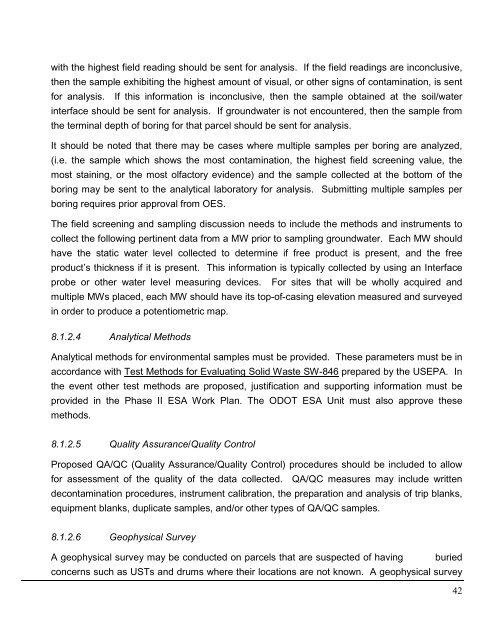Environmental Site Assessment Guidelines - Ohio Department of ...
Environmental Site Assessment Guidelines - Ohio Department of ...
Environmental Site Assessment Guidelines - Ohio Department of ...
You also want an ePaper? Increase the reach of your titles
YUMPU automatically turns print PDFs into web optimized ePapers that Google loves.
with the highest field reading should be sent for analysis. If the field readings are inconclusive,<br />
then the sample exhibiting the highest amount <strong>of</strong> visual, or other signs <strong>of</strong> contamination, is sent<br />
for analysis. If this information is inconclusive, then the sample obtained at the soil/water<br />
interface should be sent for analysis. If groundwater is not encountered, then the sample from<br />
the terminal depth <strong>of</strong> boring for that parcel should be sent for analysis.<br />
It should be noted that there may be cases where multiple samples per boring are analyzed,<br />
(i.e. the sample which shows the most contamination, the highest field screening value, the<br />
most staining, or the most olfactory evidence) and the sample collected at the bottom <strong>of</strong> the<br />
boring may be sent to the analytical laboratory for analysis. Submitting multiple samples per<br />
boring requires prior approval from OES.<br />
The field screening and sampling discussion needs to include the methods and instruments to<br />
collect the following pertinent data from a MW prior to sampling groundwater. Each MW should<br />
have the static water level collected to determine if free product is present, and the free<br />
product’s thickness if it is present. This information is typically collected by using an Interface<br />
probe or other water level measuring devices. For sites that will be wholly acquired and<br />
multiple MWs placed, each MW should have its top-<strong>of</strong>-casing elevation measured and surveyed<br />
in order to produce a potentiometric map.<br />
8.1.2.4 Analytical Methods<br />
Analytical methods for environmental samples must be provided. These parameters must be in<br />
accordance with Test Methods for Evaluating Solid Waste SW-846 prepared by the USEPA. In<br />
the event other test methods are proposed, justification and supporting information must be<br />
provided in the Phase II ESA Work Plan. The ODOT ESA Unit must also approve these<br />
methods.<br />
8.1.2.5 Quality Assurance/Quality Control<br />
Proposed QA/QC (Quality Assurance/Quality Control) procedures should be included to allow<br />
for assessment <strong>of</strong> the quality <strong>of</strong> the data collected. QA/QC measures may include written<br />
decontamination procedures, instrument calibration, the preparation and analysis <strong>of</strong> trip blanks,<br />
equipment blanks, duplicate samples, and/or other types <strong>of</strong> QA/QC samples.<br />
8.1.2.6 Geophysical Survey<br />
A geophysical survey may be conducted on parcels that are suspected <strong>of</strong> having buried<br />
concerns such as USTs and drums where their locations are not known. A geophysical survey<br />
42

















